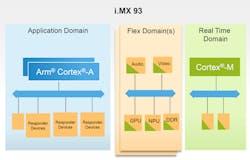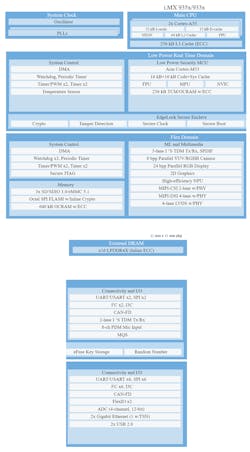This is Where Embedded SoCs are Headed
This article is part of our NXP Connect 2021 coverage.
What you’ll learn
- What is Ethos-U65?
- Why machine learning in an embedded application processor is important.
- Why the i.MX 93 is representative of things to come.
In one sense, NXP Semiconductors’ i.MX 93 system-on-chip (SoC) was not unexpected. It includes Arm’s latest complement of application processors, a microcontroller, and the Ethos-U65 neural processing unit (NPU), along with the usual complement of peripherals from serial ports to GPUs (Fig. 1). Combining Cortex-A and Cortex-M processors in an SoC is common these days; the Ethos architecture was announced by Arm years ago.
Still, being first out of the gate with cutting-edge hardware has its advantages. Developers have been chomping at the bit for good, low-power, low-cost, integrated machine-learning solutions to make the Internet of Things a bit smarter.
The NPU is grouped together within the Flex Domain that essentially includes most of the peripherals accessible by the microcontroller and application processor (Fig. 2). The Cortex-M33 has additional peripherals, so its domain can operate independent of the application processor, providing a low-power operating environment.
The EdgeLock Secure Enclave maintains its own processor and crypto support and storage. It has secure-boot and TrustZone support, as well as features like attestation. In addition, the system supports Microsoft Azure Sphere, providing secure communication and updates. The i.MX 93-CS is specifically designed for this environment. The i.MX 93 will work with other cloud solutions, too.
“We’re making it easier for developers to create, connect, and maintain innovative IoT devices by providing a comprehensive platform actively supported by the scale and expertise of Microsoft software, cloud, and security experts,” said Halina McMaster, Partner Group Program Manager, Microsoft Azure Sphere.
“Together with NXP, we are delivering a variety of Microsoft Azure Sphere-certified edge processors that provide a secured environment for customer applications, critical over-the-air update infrastructure, and more than 10 years of ongoing security improvements for every Azure Sphere chip,” continued McMaster. “The i.MX 93-CS chips will unlock opportunities across industries for performance optimization, sustainability, and safety through new classes of secured IoT devices.”
In essence, the i.MX 93 is designed to provide a secure application environment with real-time and low-power support via the Cortex-M33, and the ability to efficiently handle machine-learning applications in real-time without needing to go to the cloud for assistance. This allows data and decisions to be handled locally, as well as minimizes the amount of data to be exchanged with the cloud since the data can be massaged locally instead of sending raw data.
The Ethos-U65 can manage multiple machine-learning models simultaneously. The number and speed at which these models are handled will be application-specific, but it can easily deal with many multimedia chores as well as analyze data like motor-control information to provide preventative maintenance information. It provides more ML processing power than the dual-core Cortex-A55 and consumes less power, allowing it to operate under the auspices of the Cortex-M33 in low-power mode while the application processor is asleep.
The Cortex-M33 has its own 256 kB of RAM with ECC support. This allows the chip to run without keeping any off-board LPDDR4 running.
The Ethos-U65 is supported by NXP’s eIQ ML software development kit. This includes the eIQ Toolkit workflow tools, the GUI-based eIQ Portal development environment, and eIQ inference engine options. The software can target NXP’s array of machine-learning platforms, including the Cortex-A55 and Cortex-M33. Of course, the Ethos-U65 is more efficient, but this allows developers to distribute ML chores as needed.
The Cortex-A55 processors can run operating systems like Linux while the Cortex-M33 tends to run bare-metal applications or RTOS. A number of RTOS platforms with cloud connectivity are available.
The other part of the puzzle is NXP’s Product Longevity Program, which includes the i.MX 93. It promises at least 10 years of support for the products, and often exceeds 15 years. This is important for applications that aren’t churning out new revisions every six months.
About the Author
William G. Wong
Senior Content Director - Electronic Design and Microwaves & RF
I am Editor of Electronic Design focusing on embedded, software, and systems. As Senior Content Director, I also manage Microwaves & RF and I work with a great team of editors to provide engineers, programmers, developers and technical managers with interesting and useful articles and videos on a regular basis. Check out our free newsletters to see the latest content.
You can send press releases for new products for possible coverage on the website. I am also interested in receiving contributed articles for publishing on our website. Use our template and send to me along with a signed release form.
Check out my blog, AltEmbedded on Electronic Design, as well as his latest articles on this site that are listed below.
You can visit my social media via these links:
- AltEmbedded on Electronic Design
- Bill Wong on Facebook
- @AltEmbedded on Twitter
- Bill Wong on LinkedIn
I earned a Bachelor of Electrical Engineering at the Georgia Institute of Technology and a Masters in Computer Science from Rutgers University. I still do a bit of programming using everything from C and C++ to Rust and Ada/SPARK. I do a bit of PHP programming for Drupal websites. I have posted a few Drupal modules.
I still get a hand on software and electronic hardware. Some of this can be found on our Kit Close-Up video series. You can also see me on many of our TechXchange Talk videos. I am interested in a range of projects from robotics to artificial intelligence.



